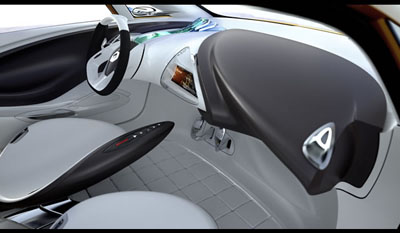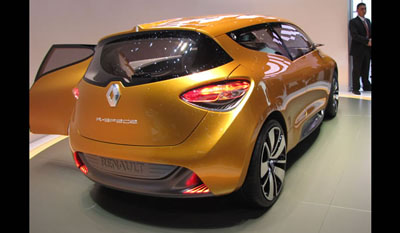Renault R-SPACE Concept 2011
The Renault R-Space Concept 2011 was unveiled at Geneva Motor Show 2011.
"R-Space brings together qualities long considered opposed: family, functionality, sportiness and sensuality," explains Axel Breun, Director of Design for Concept and Show Cars. "It answers the expectations of a large slice of our modern society."
In terms of interior design, the family likeness to the DeZir concept car is clearly visible at the front in the forms of the dashboard and seats. The driver enjoys a cockpit-like environment, with a section of the seemingly floating dashboard being specifically dedicated to driving functions.
The rear is like a play space, flexible and infinitely versatile, and formed from a simple and universal shape – the cube. Twenty-seven miniature motors power an array of height-adjustable hexahedrons, allowing four settings to be programmed, from an all-flat surface, to a booster seat, a table or a random configuration (only when the vehicle is parked) for children's games.
R-Space is powered by the Energy TCe Concept. Packed with advanced features, this direct-injection petrol engine previews the new range of modular TCe engines that Renault will begin launching onto the market next year.
With a capacity of 900cc, this three-cylinder concept-engine is a product of the Renault-Nissan Alliance. Mated to an automatic EDC double clutch gearbox, it provides the performance of a 1.6 litre engine, with peak power of 110hp/80kW and 160Nm of torque.
Its CO2 emissions have been kept to just 95g/km, equivalent to fuel consumption of just 3.7 litres/100km.
 |
 |
The Energy TCe Concept engine is an illustration not only of Renault’s strategy of downsizing, but also of the package of innovative fuel-saving, emissions-reducing technologies that will be introduced on the company’s next-generation engines. On the list are technologies such as direct fuel-injection, radio-frequency spark plugs, an EGR1 Boost system, a pulse Stop&Start system – and even a variable-displacement oil pump. In addition to work aimed at minimising internal friction, these measures have achieved a very significant reduction in fuel consumption and CO2 emissions without sacrificing performance.
Direct petrol injection: fuel is injected at high pressure directly into the combustion chamber. In combination with the radio frequency spark plugs, which boost the size of the spark (up to 1,000 times bigger than with a conventional system), the injection system raises combustion to the highest level of efficiency. This breakthrough in ignition technology has been developed in collaboration with BorgWarner Beru Systems.
As is the case with certain diesel engines, including the new dCi 130, EGR Boost technology captures the exhaust gases after they have passed through the turbocharger and after-treatment system. Cooled in a heat exchanger before being reintroduced into the air upstream of the turbo, these gases then follow the charge-air cooling circuit before entering the combustion chamber to dilute the fuel-air mixture. On petrol engines, this technique helps reduce combustion temperatures, thereby boosting the compression ratio and reducing CO2 emissions.
Pulse start: thanks in particular to the direct injection, this technology allows the ultra-rapid stopping and restarting of the engine when the vehicle is stationary.
The variable-displacement oil pump regulates the throughput of oil in line with the precise requirements of the engine, thus limiting the energy consumed by the pump. Efforts to reduce frictional losses have focused particularly closely on the 12 cam followers, timing chain and piston skirts.
A thermal management system, finally, helps the engine warm up more rapidly following a cold start. With the oil reaching its optimum viscosity more quickly, internal friction is reduced.
To further reduce fuel consumption and pollutant emissions, R-Space is fitted with a system known as DRIVINGECO². With a simple push of the "Eco" button, this system automatically adapts engine response in relation to the various parameters influencing energy consumption (altitude, ambient temperature, use of heater, etc).
R-Space is also equipped with the Visio-System which is based on a forward-facing camera dedicated to driver-assistance features.
When the camera detects a set of traffic lights changing from green to red, for example "DRIVINGECO²" advises the driver to stop accelerating. If, on the other hand, the camera detects a clear road ahead, and if the clear distance ahead permits, the advice would be to accelerate briskly to reach the required cruising speed.
Renault R-SPACE Concept 2011 Technical data :
Length – Width – Height - Wheelbase |
4,250mm - 1,850mm - 1,547mm - 2,717mm |
Engine - Power |
Petrol, turbo, direct injection - 80kW (110hp) |
CO2 emissions |
95g/km (combined cycle) |
Peak torque |
160Nm |
Top speed |
200kph |
Transmission |
Efficient Dual Clutch |
Tyres |
245 / 35 R 21 |
Cd |
0.28 |
Unladen weight |
1,300kg |
0-100kph acceleration |
11 seconds |
1,000-metre standing start |
32 seconds |
Renault R-SPACE Concept 2011 : Wallpapers